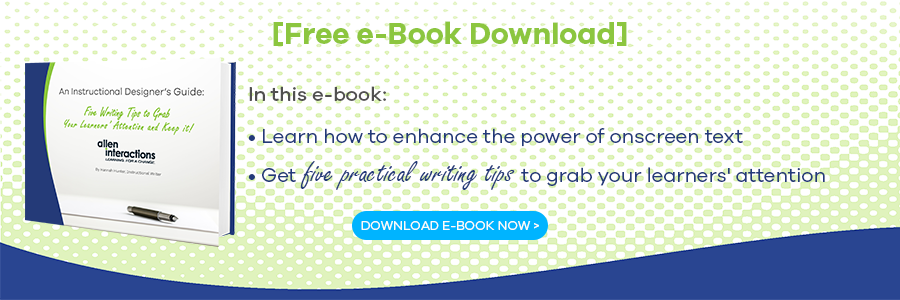Blog
4 Lenses To Bring e-Learning Instructional Design Into Focus: Part 1 - ...
By Sloane Bâby, Instructional Writer


Five Lessons We Can Learn from Millennials About e-Learning
By Sloane Bâby | September 07, 2016 | Custom Learning | 0 Comments
By Sloane Bâby, Instructional Writer
 We can learn a lot from the uber-interesting subpopulation of Gen-Y, the Millennials. No, really. We don’t understand their styles, language, or what’s “cool” anymore. I’m sorry, we don’t know what’s “on fleek,” at all. However, we can learn some valuable lessons about e-learning from this generation’s odd jargon and fresh lifestyles.
We can learn a lot from the uber-interesting subpopulation of Gen-Y, the Millennials. No, really. We don’t understand their styles, language, or what’s “cool” anymore. I’m sorry, we don’t know what’s “on fleek,” at all. However, we can learn some valuable lessons about e-learning from this generation’s odd jargon and fresh lifestyles.
Texting Shortcuts
 OMG, SRSLY? IDK, HBU? SMH…
OMG, SRSLY? IDK, HBU? SMH…
Millennials can’t (will not) spell out “because” or even “you,” but they will be quick to correct you if you use the wrong form of “your” and “there.”
Attention spans are short, whether they are that of a seasoned employee, or a Millennial new hire. People also choose what they want to focus on over a period of time—especially if they don’t want to be there.
LESSON #1:
Let’s get straight to the point in your e-learning course. The new employees of today are learning more successfully in short, efficient bursts. They would rather read a headline than an entire article. Remember this as you develop your program and keep your learner engaged with interesting, effective design. OK? TTYL.
Humble Bragging
“That awkward moment when you haven’t started work, but aced the training exam.”
The motivation to be successful can be intrinsic. It feels good to win and do well. It is really encouraging to let your boss know that you are capable of your job, even before starting!
Continuing to do better in exchange for praise is a constant motivator. Approval is also encouraging to either change your image to a more positive one or preserve your success. It is a plus if you get to brag a little bit, too.
LESSON #2:
In e-learning, in order to keep the learner’s attention fixed on what you want them to learn or achieve, he or she needs to stay motivated. Whether it’s praise or encouragement within the module, course feedback, or a rewarding knowledge check, it feels good to succeed. Keep your learner engaged, and they will feel good about their readiness for real-world tasks.
“Said no one ever.”
e.g. “‘I really love when I don’t know what I’m doing at work,’ said no one ever.”
Be realistic. Match your training to real life.
LESSON #3:
If you want your employees to know how and when to send documents to clients, for example, let them practice. Don’t just tell your learners after the fact, as in, “Oh yeah, you should have sent that yesterday,” after everyone is angry at them. “I love when people get upset at me,” said no one ever.
Snapchat
Have you used this? If not, here’s how it works in a nutshell: You take a picture, add a filter to make it look 25 times better than it really does, set it to PLAY for however many seconds you want, and send it to your friends. Then, it’s gone forever…

LESSON #4:
Here is the lesson if you can’t find a single connection between Snapchat and e-learning: Make your course memorable. You don’t want to develop and deliver an hour-long course only to watch the learners forget everything at Day One on the job. Don’t set your Snapchat filter for two seconds when you should figuratively take a screenshot in your mind for later reference.
Snapchat also allows you to create an ideal reality. Oh, you actually have three pimples and your hair is frizzy? Add a filter and you’ll automatically look like an ideal image of yourself. The Snapchat app also allows you to capture only the best, or most comical, pieces of your life.
e-Learning lesson: Choose what you want your learner to ideally do, and capture the most important pieces.
Peter Pan Generation
Millennials are waiting longer and longer to “grow up” and mark certain rites of passage off their life checklists. They are living with their moms and dads longer, getting married later, and buying a house further along in life as well, largely because college is so expensive and well-paying jobs are hard to come by soon after graduation. In short, they are doing the right thing at the right time.
LESSON #5
This is the goal of good e-learning: Get your learners to do the right thing at the right time on the job. That is what we should also get them to do in the electronic course in order for it to become more natural to them in real life scenarios.
No matter how you feel about this generation in the real world, with a little digging, the e-learning community can gather a few valuable lessons from Millennials.
SHARE THIS BLOG WITH THE READY-MADE TWEET BELOW!
 CLICK HERE TO TWEET: Five Lessons We Can Learn from #Millennials About #eLearning http://hubs.ly/H04dp680 #aiblog
CLICK HERE TO TWEET: Five Lessons We Can Learn from #Millennials About #eLearning http://hubs.ly/H04dp680 #aiblog
About the Author: Sloane Bâby
Comments
Would you like to leave a comment?
Related Blog Posts

By: Sloane Bâby | Jan, 2021
Category: Custom Learning

Blog
Pillar IV for Transformative e-Learning Instructional Design: Feedback
By Sloane Bâby, Instructional Writer
By: Sloane Bâby | Mar, 2021
Category: Custom Learning

Blog
4 Lenses To Bring e-Learning Instructional Design Into Focus With CCAF—Part ...
By Sloane Bâby, Instructional Writer
By: Sloane Bâby | Aug, 2021
Category: Custom Learning

